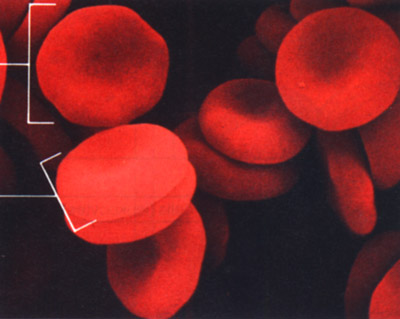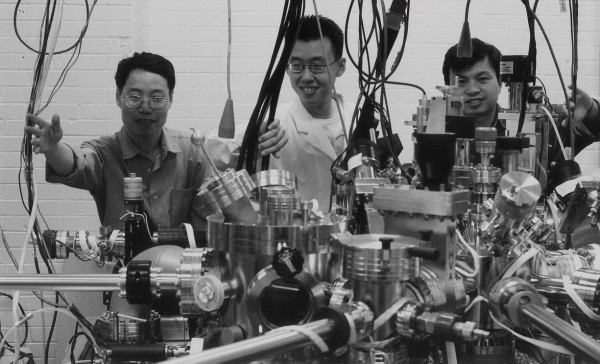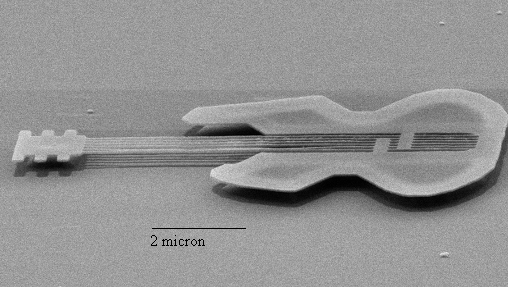Jody Mandeville and Christina Kaiser spend their days drawing patterns too small to see with anything but a very powerful electron microscope.

The size of their work is no indication of its importance since these patterns could soon be used to precisely control the colour, direction and movement of light waves within optical cables and networks. It is technology that will allow the Internet to transmit multiple video and audio streams to your computer simultaneously at ultra-high speeds.
Nanolab is what Kaiser and Mandeville call their workspace at the University of British Columbia (UBC) in Vancouver. Their minuscule works of science are part of a growing field known as nanotechnology.
Nanotechnology is the science of making, studying, and working with things on a nano-scale – in other words, really, really small. A nanometre is a millionth of a millimetre. A single human hair is almost 100 000 nanometres wide.
“The idea is, if you deal with materials and structures on that scale, they don’t behave like traditional things that are larger because new phenomena occur,” explains Harry Eugen Ruda, Professor and Director of the Energenius Centre for Advanced Nanotechnology (ECAN) at the University of Toronto.
We are all familiar with the behaviour of objects our size and the Newtonian rules of physics they follow but when things get really small and quantum rules take over, entirely new possibilities open up.
To illustrate this, if you threw a ball against a wall it would probably bounce off and come back to you. However, if the ball were less than a nanometre in diameter things would be quite different: when it hit the wall it would tunnel in the quantum scheme. That means it could actually disappear through the wall and come out the other side.
Too weird to be true? Maybe not. Devices have already been invented to take advantage of electron tunnelling. One of them is the Scanning Tunnelling Microscope (STM), one of the most valuable tools available to nanotechnology researchers. Gerd Binnig and Heinrich Rohrer won the Nobel Prize in physics in 1986 for having invented this simple but amazing machine only four years earlier. With the STM, researchers can look at individual atoms, and pick them up and move them around.

It all sounds like the stuff of science fiction novels, but much of it is close to becoming reality. Nanotechnology is in the process of revolutionizing communications, computing, and medicine, “Small devices could have applications well beyond simple computing, and one of the most exciting areas in which it has great potential is in medicine. There are a few functions which I think are obviously on the horizon in the medical area,” Ruda says optimistically, “for example, artificial senses: artificial noses, the artificial retina, the artificial eye.”
He also agrees with predictions that the technology to make computer chips smaller and self-assemble small numbers of molecules on a surface will soon make diagnostic sensors and biosensors available to doctors. In fact, he suggests that it’s not unrealistic to imagine that these chips could actually be sent through our blood vessels to target areas of the body and transmit their findings back to a computer in the doctor’s office via radio waves.
It seems obvious that nanotechnology is the wave of the future and will become an intricate part of our everyday lives. “I think nanotechnology will be the technology,” says Ruda. “By the time we look to 2010 it will all be nanotechnology… it’s at the threshold of being totally pervasive.”
Dealing with the phenomena of nanotechnology is becoming inevitable in some fields. In particular, the computer industry is currently pushing the physical limits of how much information we move around and how fast we can do it using traditional methods.
“With the Internet, everyone wants real-time video, multiple computers at home and different video and audio channels at the same time,” said Jeff Young, Assistant Professor in the Physics Department at UBC. “So the more things people want like that, the more technology we have to build into the system.”
Young has been studying properties of light, semiconductors and electronics since his days as a graduate student. While at UBC he saw an opportunity to complement the existing research and started his work on nanostructures. “Nano can mean all kinds of different things,” says Young.

This big machine makes the little machines…
In his lab, it refers to the size of the patterns Mandeville, Kaiser, and the other students use to harness and control light. By splitting light into thousands of colours, coding a different stream of data in each one, and sending it all down the same cable over long distances at the speed of light, researchers of “photonic” nanotechnology hope to dramatically raise the number of lanes – and the speed limit – on the information highway.
But it’s not good enough to move huge amounts of information quickly if your computer can’t handle it. Making things smaller also happens to be the most logical route to greater computing power and speed for two reasons, explains Ruda, “If the distance between A and B are shorter, information will pass faster which makes the circuit work quicker.”
“The other reason,” states Ruda, “is that when you have things closer together, then you can pack more devices on the same area of chip.” And if computer chips shrink down to a size where quantum effects can be harnessed, computing as we know it may suddenly evolve into something quite different.
Still, no technology comes easily. Mandeville explains that the work can be deeply frustrating, but both he and Kaiser feel that when things work out, it’s all worthwhile. “I get a huge sense of satisfaction looking at the finished product,” …through an electron microscope, of course.
The nanoguitar. The world’s smallest guitar is 10 micrometers long — about the size of a single cell — with six strings each about 50 nanometers, or 100 atoms, wide. Made by Cornell University researchers from crystalline silicon, it demonstrates a new technology for a generation of electromechanical devices that could have a variety of uses in fiber optics, displays, sensors and electronics.
Photo courtesy of D. Carr and H. Craighead, Cornell
Written by Faze contributor Emily Chung


Nanoscience and nanotechnology is a very promising field. It is the study of extremely small things in different domains of science